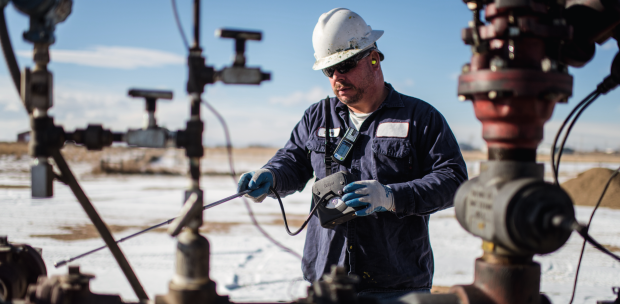
From Sensors to Data Logging
Most devices with data logging retain monitoring information whenever they are turned on. This can provide use snapshots of conditions at the time of an accident or unusual event.
- By Larry Medina
- Jan 01, 2018
There is no such thing as "one size fits all" in the world of safety, especially when it comes to choosing a gas detector. Each work site has a unique set of challenges, and to ensure optimal safety for on-site workers, selecting a device becomes a critical choice for many safety managers. With several factors to consider––the gases and vapors potentially present on the work site, the areas of risk, fixed vs. portable detectors, etc.––finalizing the "right" safety suite can oftentimes be daunting. Here are a few tips that can help safety managers as they set out to identify the detector that is best suited for their workplace.
Understand the Environment
It's critical for safety managers to conduct a risk assessment to fully understand all aspects of risk on the work site, including if there is a potential presence of combustibles, toxic gases and volatile organic compounds (VOCs). Additionally, hazards such as oxygen enrichment—a condition that can cause materials to burn more vigorously than they would under normal circumstances—and oxygen deficiency can impact the device that’s ultimately selected. For example, an influx of inert gases can deplete an area’s oxygen concentration, presenting potential consequences that could hinder mental and physical performance or cause a severe loss of consciousness. As such, selecting a device that addresses these conditions becomes critical.
This evaluation testing will determine the necessary steps to ensure that conditions are safe for work. Once evaluation testing has been completed, ongoing verification testing can be done to ensure any and all chemical hazards are below the levels necessary for safe operation.
Sensor Selection
Once there's been a proper assessment of the surrounding environment, consider which types of sensors can accommodate the application, and ensure the chosen sensors reflect and address the known and potential atmospheric hazards. In situations where the environment is a confined space, portable gas detectors will often feature a catalytic sensor for the measurement of combustible gases, and one or two electrochemical sensors. Catalytic sensors are useful toward detecting concentrations in the lower exposure level (LEL), the smallest concentration of vapor in air below which a flame will not ignite (even in the company of an ignition source), whereas electrochemical sensors are best suited for detecting specific toxic gases. The oxygen reading is the first reading taken in preparation for a confined space entry in order to ensure that there are appropriate oxygen levels, and to also verify that there is enough oxygen for the proper operation of the CatEx sensor.
Other types of sensors include photoionization detectors (PIDs), which measure a broad range of VOCs such as methane, benzene, or hydrocarbons that occur in oil drilling and refining, or infrared sensors that can directly measure carbon dioxide or methane.
The number of sensor configurations is large; however, safety managers are able to tailor their selection to best suit their workers’ needs.
Opt for Durability
Detectors that are more resilient are more likely to have a longer lifespan and thus lead to lower long-term costs. However, it’s also crucial for safety managers to consider whether the portable gas detector material is suited for the wear-and-tear of their unique workplace environment. For example, if an environment is threatened by special gases such as hydrogen peroxide, hydrogen chloride, or hydrogen fluoride (all of which are particularly hard to detect because they adsorb to different surfaces), consider using a gas detector with an open gas inlet. This feature can prevent adsorbing surfaces from coming between the detector and the gas that is being detected to ensure workers' safety.
Assess the Accessories
Oftentimes, incorporating accessories to portable gas detectors can prove to be handy for many safety managers and help them tailor their safety devices to fit their specific workplaces. For example, motorized pumps can be attached in order to allow workers to use their portable gas detectors both as diffusion (which utilizes natural air currents to bring the sampled atmosphere into the instrument) and sample-draw (which mechanically draws the atmosphere into the detector for sampling) instruments. Pumps are particularly useful for reaching ambient atmospheres in inaccessible places such as tanks, channels, or shafts.
Keeping a Record
Beyond identifying and alerting workers about the presence of gases, consider whether data logging features are important to daily operations. Most devices with data logging retain monitoring information whenever they are turned on. Oftentimes in the event of an accident or unusual incident, this can provide use snapshots of conditions at the time of the event. It also proves to be helpful for calibration and bump tests because most data logging instruments automatically update and store calibration information such as dates.
If devices operate both via diffusion and sample-draw modes (especially in the case of a pump attachment), safety managers may consider using instruments that make it possible to differentiate between measurements taken with or without the pump attached.
Whether they're working in oil & gas or on a plant in the chemical, pharma, or other industry, safety managers are always looking to best maximize their workers' safety. By tailoring their devices to fulfill the demands and requirements of their applications, safety managers can move one step closer to achieving their goal.
This article originally appeared in the January 2018 issue of Occupational Health & Safety.